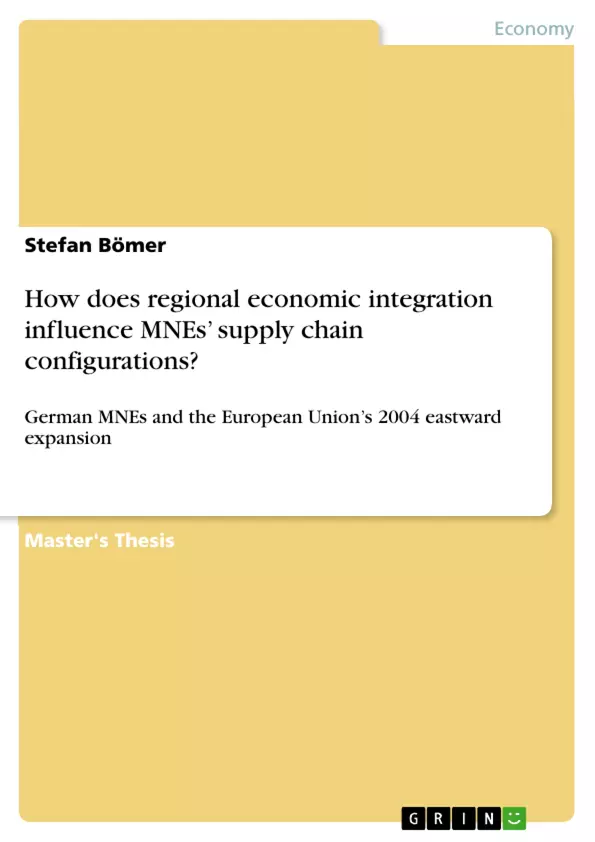The paper will investigate the influence of RTAs on MNEs’ supply chain configurations. To do so, the behaviour of German MNE's after the 2004 EU enlargement will be considered, and German MNE's’ supply chain activities in the new EU member states before and after the countries’ accessions will be compared.
In contrast to previous research focusing on FDI and trade flows, this research, based on secondary data of the German Central Bank and the World Bank Group, relies on further indicators to capture the effects of supply chain configuration. Supply chain activities of German MNEs' in the Czech Republic, Latvia, Poland and Slovenia grew faster after 2004, while in Estonia a slower growth in supply chain activities post 2004 was noticeable.
For the case of Cyprus, Hungary, Lithuania, Malta and Slovakia an overall positive development after 2004 was observable even though for single indicators a slower growth was detected. The results demonstrated that the EU accession increased German MNEs’ supply chain activities in the new EU member countries, but country differences, based on locational characteristics the individual countries possess, exist.
Inhaltsverzeichnis (Table of Contents)
- Introduction
- Literature Review
- Methodology
- Data
- Concepts and Operationalisation
- Analysis and Strategy
- Analysis of Findings
- German MNEs' supply chain activities in the EU-10
- Locational differences in German MNEs' supply chain activities
- The beautiful swans: Czech Republic, Latvia, Poland, and Slovenia
- The ugly duckling: Estonia
- Conclusion
- Reference List
- Appendix
Zielsetzung und Themenschwerpunkte (Objectives and Key Themes)
This dissertation examines the impact of regional trade agreements (RTAs) on supply chain configurations of German multinational enterprises (MNEs) in the European Union, focusing on the expansion of the EU to include Cyprus, the Czech Republic, Estonia, Hungary, Latvia, Lithuania, Malta, Poland, Slovakia, and Slovenia (EU-10) in 2004. The study analyzes the changes in supply chain activities of German MNEs in these new EU member states before and after their accession, using a variety of indicators beyond traditional FDI analysis. The research aims to understand how RTAs influence MNEs' decisions regarding supply chain configuration and whether these decisions were influenced by the EU enlargement.
- The impact of RTAs on MNEs' supply chain configurations
- The influence of the EU enlargement on German MNEs' supply chain activities in the EU-10
- Locational differences in supply chain activities based on country-specific characteristics
- The role of various indicators beyond FDI in analyzing supply chain configurations
- The potential implications of RTAs for future supply chain decisions in the context of Brexit
Zusammenfassung der Kapitel (Chapter Summaries)
The introduction provides a background to the topic, highlighting the importance of RTAs in shaping MNEs' supply chain configurations. It emphasizes the case of the EU enlargement and the role of the EU-10 as host countries for German MNEs. The chapter outlines the research objectives and the significance of investigating supply chain configuration beyond traditional FDI and trade flow analysis.
The literature review examines existing research on the effects of RTAs on FDI and trade flows. It discusses the concept of supply chain configuration and its relevance to MNEs operating in changing environments. The review also explores the advantages and disadvantages of offshoring and its impact on supply chain efficiency.
The methodology chapter outlines the data sources and indicators used in the study. It explains the operationalization of key concepts and the analytical strategy employed to investigate the research questions.
The chapter on analysis of findings presents the results of the study, examining the impact of the EU enlargement on German MNEs' supply chain activities in the EU-10. It compares pre- and post-accession data to identify changes in supply chain activities and explores country-specific differences in supply chain configurations.
Schlüsselwörter (Keywords)
The research explores the influence of regional economic integration, specifically the EU's 2004 eastward expansion, on the supply chain configurations of German MNEs. It examines the role of trade agreements, FDI, and other indicators in shaping supply chain decisions. The research focuses on key concepts such as offshoring, supply chain efficiency, locational advantages, and country-specific characteristics.
- Quote paper
- Stefan Bömer (Author), 2018, How does regional economic integration influence MNEs’ supply chain configurations?, Munich, GRIN Verlag, https://www.grin.com/document/1166988



